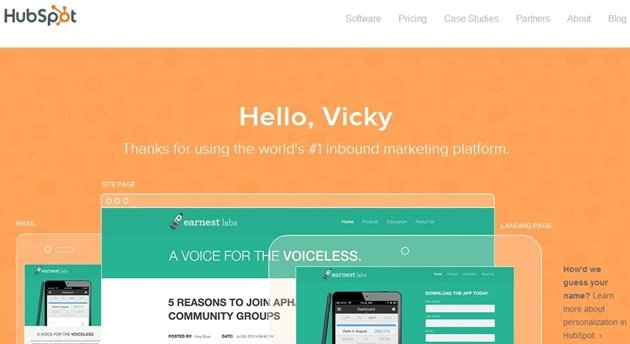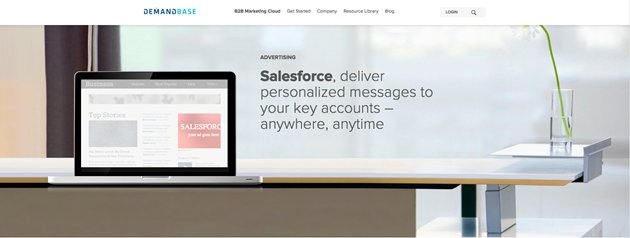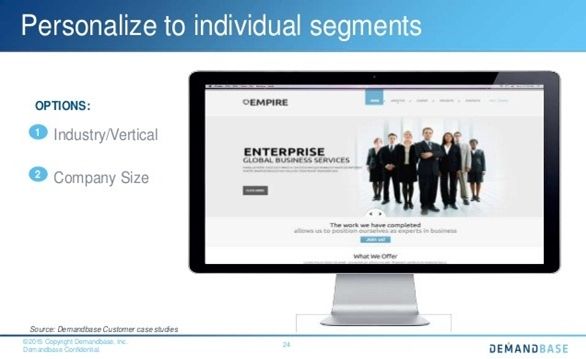Generating qualified leads remains a top challenges for B2B marketers: 77% of B2B marketers said improving lead quality was their top priority in 2017—more important than increasing the quantity of leads (41%) or reducing costs (24%)—according to a survey by Ascend2.
In turn, DemandGenReport's 2017 B2B survey highlighted three trends that vendors need to consider to earn the attention and gain the trust of modern B2B buyers:
- Relevant content is the key: 75% of B2B buyers said it is very important that the vendor's website present relevant content that speaks directly to their company; 66% said it is very important that the website address the needs of their industry.
- Buyers expect customized content relevant to their needs regardless of whether the supplier has access to their personal information: 71% of buyers expect an experience tailored to their individual interests and needs even if they conduct an anonymous search.
- Buyers become more risk-averse: They focus more on risk mitigation, especially as the number of stakeholders involved in buying decisions increases along with the length and complexity of the buying journeys.
This article will discuss how B2B businesses can address those key trends to improve the quality of their lead-generation efforts.
1. Buyer Personas: Key to Personalization
B2B suppliers that use personalized content in the marketing and sales process reap great benefits. According to a survey conducted by Seismic and Demand Metric, over 60% of B2B businesses that use a content personalization strategy consider it more effective than non-personalized content.
Seismic and Demand Metric define five types of personalization strategies:
- Segment-specific: personalized by industry vertical or segment criteria
- Persona-specific: personalized for specific buyer types
- Stage-specific: personalized for a stage of the buying process
- Account-specific: personalized for a specific prospect organization
- Lead-specific: personalized for an individual lead
The data suggest that persona-specific personalization is typically more efficient than personalizing content for an individual company or lead. Referral SaaS Squatch defines five components of building a successful buyer persona:
- Role in the buying process
- Fears and challenges
- Drivers and motivators
- Organizational goal and priorities
- Problems and issues

Example of a buyer persona that you can use in your personalization strategy (Source: Mycustomer.com)
You can dynamically personalize landing pages or email headers by mentioning relevant information, such as account name and their industry or company size. Once you've gained the buyer's attention, present him/her with content that is relevant according to his/her specific buyer persona.

Landing-page personalization by name, implementation by Hubspot

Landing-page personalization by company name, implementation by DemandBase SalesForce)

Landing-page personalization by company size, implementation by DemandBase (source: DemandBase)
2. Customizing the Digital Experience for Every Visitor
It might seem impossible to customize website content for each individual visitor persona if you don't have any relevant information about your buyers.
However, interactive selection-support solutions can help you to provide buyers with relevant content, products, or solutions even if they browse your website anonymously. These solutions typically ask visitors targeted questions related to their buyer persona, such as these:
- What's your industry or vertical?
- How big is your company?
- What are the key issues you are facing?
- What are your business objectives?
After the visitor has answered the questions, he/she is presented with most relevant content or the most suitable solution relevant to their buyer persona and business needs.
For example, Swisscom, Switzerland's leading telecom company, launched an interactive adviser that pre-qualifies leads and presents them with business solutions relevant to their needs.

The Swisscom B2B Solution Advisor allows users to quickly and easily identify suitable products for their business
3. Reassuring Your Buyers With a Freemium Version of Your Product
As buyers become more risk-averse, offering a freemium version of your solution can help reduce the perceived risk. "Freemium" refers to a system through which companies can offer basic products or services free of charge while presenting customers with the option to upgrade to a paid, premium version. (Freemium apps account for about 98% of Google Play revenue worldwide.)
As with most pricing strategies, there are pros and cons to a freemium strategy, but there are also some benefits for lead generation:
- The ability to give your customers a taste of your product. There's a delicate balance to manage when creating a freemium product: You need to make sure that the product you create is compelling enough to capture the interest of your audience, and make them want more, all while not giving away too much.
- Eliminating the buyers' obstacles in the acquisition process. Positive ROI is one of the primary concerns of B2B buyers. They're worried about investing into your solution without any promise of value in return. If they don't have to pay anything to try your product out, that concern is eliminated.
- Getting the user hooked. If your lead gets used to relying on your product—even just the free version—you will have created a level of loyalty, and you can at a later stage convince the lead to become a customer. The concept is simple: Get people onboard for free, allow them to get used to your product, and then shift them over to the premium model.
Some examples of freemium done well:
- Wistia: The Wistia freemium plan is ideal for B2B companies that are just beginning to explore the benefits of video marketing. This offering helps Wistia to capture a broader audience for its product, rather than simply relying on people who have already tried video marketing or have established a video marketing plan.
- Mailchimp: If you have fewer than 2,000 contacts in your B2B database, then you can use the MailChimp "Entrepreneur" plan. This freemium offering gives Mailchimp the chance to capture smaller businesses with its marketing efforts rather than just marketing to enterprises. As the smaller business grows, or its needs change, the chances are it'll be more likely to upgrade with Mailchimp—because the business has already grown used to the product.
- Zuvoo: The freemium version of SMARTASSISTANT allows clients to get involved with the platform and appreciate the benefits of "guided selling." It also allows SMARTASSISTANT to create a database of community-generated templates that are helpful for clients who don't have the resources or time to build their own templates from scratch.
(To benefit from a freemium model, remember to consider key criteria for your freemium success, as laid out in a TechCrunch article.)
The expectations of modern B2B buyers are high, and they are only going to grow in the future. Providing a highly customized Web experience and helping to reduce perceived risk connected with your solution will help you overcome the obstacles that might prevent your audience from taking the next step in the buying process.




